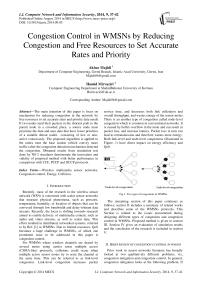Congestion Control in WMSNs by Reducing Congestion and Free Resources to Set Accurate Rates and Priority
Автор: Akbar Majidi, Hamid Mirvaziri
Журнал: International Journal of Computer Network and Information Security(IJCNIS) @ijcnis
Статья в выпуске: 9 vol.6, 2014 года.
Бесплатный доступ
The main intention of this paper is focus on mechanism for reducing congestion in the network by free resources to set accurate rates and priority data needs. If two nodes send their packets in the shortest path to the parent node in a crowded place, a source node must prioritize the data and uses data that have lower priorities of a suitable detour nodes consisting of low or non- active consciously. The proposed algorithm is applied to the nodes near the base station (which convey more traffic) after the congestion detection mechanism detected the congestion. Obtained results from simulation test done by NS-2 simulator demonstrate the innovation and validity of proposed method with better performance in comparison with CCF, PCCP and DCCP protocols.
Wireless multimedia sensor networks, Congestion control, Energy, Collision
Короткий адрес: https://sciup.org/15011340
IDR: 15011340
Текст научной статьи Congestion Control in WMSNs by Reducing Congestion and Free Resources to Set Accurate Rates and Priority
Published Online August 2014 in MECS DOI: 10.5815/ijcnis.2014.09.05
Recently, most of the research in the wireless sensor network (WSN) is concerned with scalar sensor networks that measure physical phenomena, such as pressure, temperature, humidity, or location of objects that can be conveyed through low bandwidth and delay-tolerant data streams. Recently, the focus is shifting toward= research aimed to enable delivery of multimedia content, such as audio and video streams, as well as scalar data. This effort resulted in distributed, networked systems, referred to by Ref. [1] as WMSNs. Due to limited resources, QoS becomes a huge challenge in WMSNs, of which one prominent issue to be addressed in this paper is congestion control.
For WMSNs where wireless channels are shared by several motes using carrier sense multiple access (CSMA-like) protocols, collisions could occur when multiple active sensor motes try to seize the channel at the same time. This can be referred to as link-level congestion. Link-level congestion increases packet service time, and decreases both link utilization and overall throughput, and wastes energy of the sensor motes. There is an another type of congestion called node-level congestion which is common in conventional networks. It is caused by buffer overflow in the mote and can result in packet loss, and increase latency. Packet loss in turn can lead to retransmission and therefore wastes more energy. Both link-level and node-level congestions (illustrated in Figure. 1) have direct impact on energy efficiency and QoS.

Fig.1. Two types of congestions in WMSNs
The remaining section of this paper continues as follows; section II includes a summary of related works and describes some of the WMSNs protocols. This Section is related to the issues encountered during designing different types of congestion and congestion control in WMSNs. Proposed method is given in section III. Section IV gives an evaluation of simulation results and the conclusion of the research is included in section V.
-
II. Brief review of congestion ccontrol in wmsns
Prior work in sensor networks literature has broadly looked at two qualitatively different problems, viz, congestion mitigation and congestion control. In general, congestion mitigation looks at the following problem. If in a sensor network, the nodes are provisioned to sense the environment and send periodic samples at a fixed rate, then, when the aggregate traffic exceeds the network capacity, how should the nodes regulate their transmissions so that the network good put and fairness degrade gracefully. This is different from congestion control, which seeks to find an optimal fair rate for the sensor nodes that is also maximally efficient.
In this case, when the nodes transmit data at the optimal rate, the network is maximally utilized, and the per node good put is close to the sending rate. Adaptive Rate Control (ARC) [19] monitors the injection of packets into the traffic stream as well as route-through traffic. Each node estimates the number of upstream nodes and the bandwidth is split proportionally between route-through and locally generated traffic, with preference given to the former. The resulting bandwidth allocated to each node is thus approximately fair. Also, reduction in transmission rate of route-through traffic has a backpressure effect on upstream nodes, which in turn can reduce their transmission rates.
In [16], the authors propose Congestion Detection and Avoidance (CODA). CODA uses several mechanisms to alleviate congestion. In open-loop hop-by-hop backpressure, when a node experiences congestion, it broadcasts back-pressure messages upstream towards the source nodes, informing them of the need to reduce their sending rates. In closed-loop multi-source regulation, the sink asserts congestion control over multiple sources. Acknowledgements (ACKs) are required by the sources to determine their sending rates when traffic load exceeds the channel capacity. In general, open-loop control is more appropriate for transient congestion, while, closed loop control is better for persistent congestion.
In [14], the authors propose the event-to-sink reliable transport protocol. ESRT allocates transmission rates to sensors such that an application-defined number of sensor readings are received at the sink, while ensuring the network is uncongested. The rate allocation is centrally computed at the base station. ESRT monitors the local buffer level of sensor nodes and sets a congestion notification bit in the packets it forwards to the sink if the buffer overflows.
If a sink receives a packet with the congestion notification bit set, it infers congestion and broadcasts a control signal informing all sources to reduce their common reporting frequency. However, this approach suffers from a few drawbacks.
Firstly, since the sink must broadcast this control signal at a high energy to allow all the sources to hear it, an ongoing event transmission can be disrupted by this high powered congestion signal. Moreover, rate regulating all sources as proposed in [14], is fine for homogeneous applications, where all sensors in the network have the same reporting rate but not for heterogeneous ones.
Even with a network where all the sources have a uniform reporting rate, ESRT always regulates all sources regardless of where the hotspot occurs in the sensor network.
The control law used by ESRT is based on empirically derived regions of operation, and does not attempt to find a fair and efficient rate allocation for the nodes. Fusion [8] is a congestion mitigation technique that uses queue lengths to detect congestion. Fusion uses three different techniques to alleviate congestion, via, hop-by-hop flow control, rate limiting, and a prioritized MAC. Hop-by-hop flow control prevents nodes from transmitting if their packets are only destined to be dropped downstream due to insufficient buffer spaces. Rate limiting meters traffic being admitted into the network to prevent unfairness towards sources far away from the sink. A prioritized MAC ensures that congested nodes receive prioritized access to the channel, allowing output queues to drain. Fusion focuses on congestion mitigation and does not seek to find an optimal transmission rate for the nodes that is both fair and efficient. In [13], the authors proposed the Interference Aware Fair Rate Control protocol (IFRC). IFRC is a distributed rate allocation scheme that uses queue sizes to detect congestion, and further shares the congestion state through overhearing. Congestion Control and Fairness for Many-to-one Routing in Sensor Networks [3] is another rate allocation scheme that uses a different mechanism than IFRC.
Both IFRC and [3] are tangentially related to our work in the sense that they attempt to find optimal transmission rates for all nodes, such that, congestion collapse is avoided. Note that, our algorithm has greater flexibility than IFRC and [3], since many different traffic allocation policies can be implemented in our congestion control scheme, without changing the basic congestion control module (the utility controller).
Moreover, IFRC suffers from the additional drawback of having sophisticated parameter tuning for stability, unlike ours. In [11], the authors propose the Rate Controlled Reliable Transport protocol (RCRT). This protocol is built for loss-intolerant applications that require reliable transport of data from the source nodes to the sink. RCRT uses end-to-end explicit loss recovery by implementing a NACK based scheme.
Furthermore, RCRT places all congestion detection and rate adaptation functionality in the sinks, thereby producing a centralized congestion control scheme. The authors in [9] proposes a congestion control mechanism, in which, the buffer in each node is adjusted according to the transmitting downstream nodes in order to minimize packet drop; the algorithm automatically adjusts a node’s forwarding rate to avoid packet drops due to congestion. The algorithm resolves the fairness problem by allocating equal bandwidth to the sources. The authors in [16] propose a rate-based fairness-aware congestion control (FACC) protocol, which controls congestion and achieves approximately fair bandwidth allocation for different flows.
Their congestion control is based on probabilistic dropping based on queue occupancy and hit frequency.
Our congestion control is in contrast to these works as it abstracts the notion of fairness, allowing it to assume different fairness models, such as weighted fairness. In
[16], the authors propose a hop by hop predictive congestion control scheme for WSNs.
Their algorithm detects the onset of congestion using queue utilization and a channel estimator algorithm that predicts the channel quality. Flow control is then achieved by a back off interval selection scheme.
Though, in this paper, we focus on congestion control in sensor networks, it will not be out of place to discuss some recent work on congestion control in wireless network in general. The authors in [13] propose a crosslayer optimization scheme for congestion control in multi-hop wireless networks.
They implement a differential backlog based MAC scheduling and router-assisted backpressure congestion control scheme using real off-shelf radios. In [14], the authors focus on fair bandwidth sharing between end to end flows, while maintaining an efficient overall throughput in the network. They propose a dynamic rate allocation solution that is based on a simple radio sharing model. In the next section, we will formulate our problem and also discuss the rationale behind our solution approach.
Various congestion control methods have been studied for wireless sensor networks. Among them, most popular techniques are CCF, PCCP and DCCP.
As was shown in[6], CCF is a non-work-conserving algorithm. To explain the non-work-conserving property of CCF, suppose that a root node is connected to two nodes A and B. The non-work-conserving property of CCF implies that the root node will wait until the required number of packets has been received and transmitted from node B before considering packets from node A. This also implies that CCF cannot effectively allocate the remaining capacity, resulting in a low throughput, especially, when some nodes do not have any packet to send. Further, as was shown in [6], CCF has another major problem. The rate adjustment in CCF relies only on packet service time which could lead to low utilization when some sensor nodes do not have enough traffic or there is a significant packet error rate.
Priority based congestion control protocol (PCCP) was Proposed in[6]. PCCP is an upstream congestion control protocol for WSNs which measures the congestion degree as the ratio of packet inter-arrival time to the packet service time. Based on the introduced congestion degree and node priority index, PCCP utilizes a cross-layer optimization and imposes a hop-by-hop approach to control congestion. It has also been shown that PCCP achieves efficient congestion control and flexible weighted fairness for both single-path and multipath routing. In wireless sensor networks data are normally generated and sent to the sink periodically. However, a burst of data traffic can also be suddenly generated when an important event is triggered or detected. So, in wireless sensor networks different data packets might have different importance. For packets containing information with higher importance, the network should make more effort in delivering them. This highlights a need for having service differentiation in sensor networks. Service differentiation in wireless sensor networks is a new research area and a few methods have been proposed[6].
The Datagram Congestion Control Protocol (DCCP) is a message-oriented transport layer protocol. DCCP implements reliable connection setup, teardown, Explicit Congestion Notification (ECN), congestion control, and feature negotiation. DCCP was published as RFC 4340, a proposed standard, by the IETF in March, 2006. RFC 4336 provides an introduction. FreeBSD had an implementation for version 5.1.[1] Linux also had an implementation of DCCP first released in Linux kernel version 2.6.14 (released October 28, 2005).
DCCP provides a way to gain access to congestion control mechanisms without having to implement them at the application layer. It allows for flow-based semantics like in Transmission Control Protocol (TCP), but does not provide reliable in-order delivery. Sequenced delivery within multiple streams as in the Stream Control Transmission Protocol (SCTP) is not available in DCCP.
DCCP is useful for applications with timing constraints on the delivery of data. Such applications include streaming media, multiplayer online games and Internet telephony.
The primary feature of these applications is that old messages quickly become stale so that getting new messages is preferred to resending lost messages. Currently such applications have often either settled for TCP or used User Datagram Protocol (UDP) and implemented their own congestion control mechanisms, or have no congestion control at all.
While being useful for these applications, DCCP can also be positioned as a general congestion control mechanism for UDP-based applications, by adding, as needed, a mechanism for reliable and/or in-order delivery on the top of UDP/DCCP. In this context, DCCP allows the use of different, but generally TCP-friendly congestion control mechanisms [9].
-
III. Details of the proposed scenarios
The proposed method called reliability and congestion control protocol that has two basic functions responsible for the reliability and congestion control.
The main intention of this protocol is to be used as a mechanism for reducing congestion in the network by free resources to set accurate rates and priority data needs. If two nodes send their packets in the shortest path to the parent node in a crowded place, a source node must prioritize the data and uses data that have lower priorities of a suitable detour nodes consisting of low or nonactive consciously.
Due to the limited energy of sensor node, existing trails will be used instead of creating new routes.
The proposed protocols are tried to increase network lifetime and the rate of successful packet transfer by reduction of possibility of packet loss as much as possible.
As we know there are two types of traffic at each node, local traffic and transmitted traffic. In fact, each node can act as a source and as a router in the network. Source traffic is created locally and by the node itself if the transmitted traffic is created through other nodes and are sent to the upstream node to be sent to the scrap.
As can be inferred, the tree structure has a kind of injustice in terms of bandwidth allocation for sensor network nodes located at different levels so that nodes near the sink are given a higher priority but farther nodes have to send data through intermediate nodes, passing several steps with great delay.
To solve this problem, the proposed algorithm uses a priority mechanism. Each packet contains two types of real-time and non- real-time priority. Immediate priority is an integer constant and the minimum value for the priority of a packet is equal to zero.
Immediate priorities of the packet varies based on parameters of the number of steps elapsed like ageing algorithm, in such a way that much greater chance for larger number of the immediate packet. In figure 2 the proposed congestion control protocols presented.
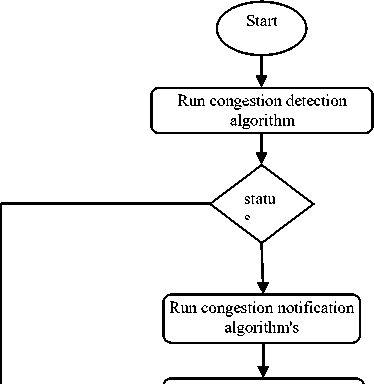
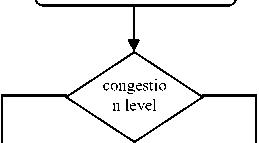
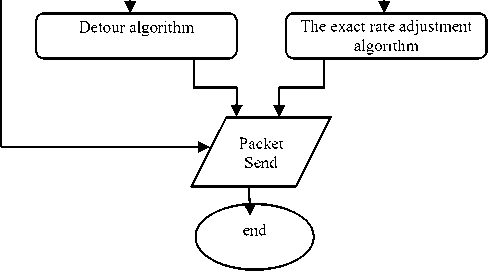
Fig.2. Scheme of the proposed congestion control protocols
-
IV. Simulation results
We choose NS-2 simulator for simulation because it’s flexible and better performance. Values assigned to the parameters for simulation are table 1.
Table 1. Values of Parameters for simulation
Simulator
Routing Protocols Simulation duration Simulation area Number of nodes Transmission range Movement model MAC Layer Protocol Queue Size
Packet rate Traffic type Data payload
NS2 2.34 and 2.32
AODV
-
40, 60, 80, 100, 120, 140 500m X 500m
-
10 m
Chain topology
CCF, PCCP, DCCP
-
2 packets/sec CBR (UDP) 256 bytes/packet
We compared our Model with CCF, PCCP and DCCP protocols. This is the reason that the proposed model shows average delay and packet loss.
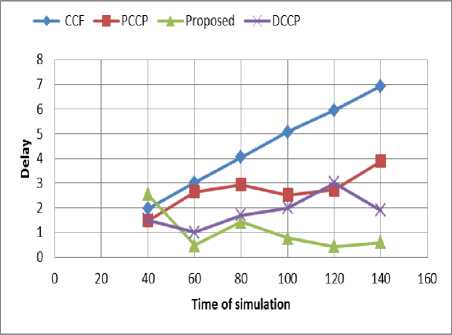
Fig.3. Average Network Delay
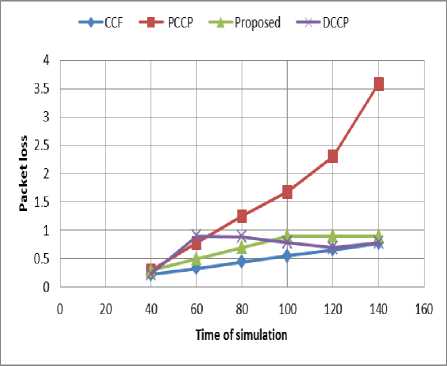
Fig.4. Packet Loss
Congestion control is directly related to energy consumption, the Figure five expresses this fact that proposed model optimize the energy consumption and have a longer network lifetime in comparison with CCF, PCCP and DCCP protocols.
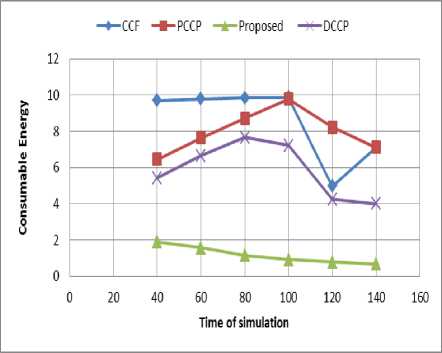
Fig.5. Power Consumption Network
Figure six and seven illustrated that, proposed model is better in terms of average throughput and packet delivery ratio respectively.
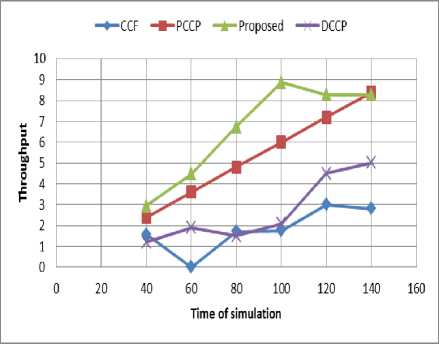
Fig.6. Average Throughput
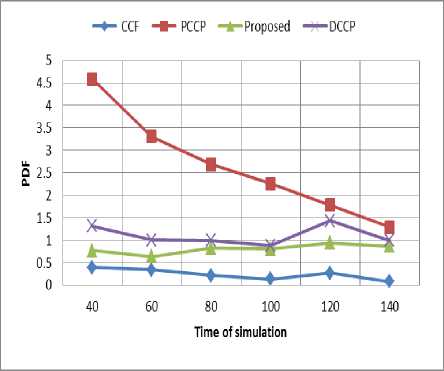
Fig.7. Packet Delivery Ratio
-
V. Conclusion
New applications made possible by rapid improvements and miniaturization in hardware has motivated recent developments in wireless multimedia sensor networks (WMSNs). To provide the required quality of service for multimedia applications in WMSNs, congestion control is necessary. Each congestion control protocol should be able to detect congestion in advance, and allocate available rates to the sensor nodes accordingly. In this paper we presented a model for congestion control in WMSNs. The main intention of this protocol is to be used as a mechanism for reducing congestion in the network by free resources to set accurate rates and priority data needs. If two nodes send their packets in the shortest path to the parent node in a crowded place, a source node must prioritize the data and uses data that have lower priorities of a suitable detour nodes consisting of low or non- active consciously. The proposed algorithm is not applied in normal case since computation is a time consumer manner. Accordingly, the proposed algorithm is applied to the nodes near the base station (which convey more traffic) after the congestion detection mechanism detected the congestion.
Список литературы Congestion Control in WMSNs by Reducing Congestion and Free Resources to Set Accurate Rates and Priority
- Akbar MAJIDI, Hamid MIRVAZIRI. BDCC: Backpressure routing and dynamic prioritization for congestion control in WMSNs. I.J. Computer Network and Information Security; 2014, 5, 29-34.
- Akyildiz I, Melodia WT, Chowdhury KR. A survey on wireless multimedia sensor networks. Computer Networks 2007; 51:921–960.
- Akyıldız IF, Su W, Sankarasubramaniam Y, Çayırcı E. Wireless Sensor Networks: Survey. Computer Networks 2002; 38:393–422.
- Neely M. J and Urgaonkar R. Optimal Backpressure Routing in Wireless Networks with Multi-Receiver Diversity. Ad Hoc Networks 2009; 7: 862-881.
- H.A. Shayanfar, E.S. Barazandeh, S.J. Seyed Shenava, A. Ghasemi, O. Abedinia. SOLVING OPTIMAL UNIT COMMITMENT BY IMPROVED HONEY BEE MATING OPTIMIZATION. International Journal on “Technical and Physical Problems of Engineering” (IJTPE) 2012; 4, 38-45.
- Yaghmaee MH, Adjerohb DA. Priority-based rate control for service differentiation and congestion control in wireless multimedia sensor networks.Computer Networks 2009; 53: 1798–1811.
- LIN Q, Wang R, Jian. Novel congestion control approach in wireless multimedia sensor networks. Journal of China Universities of Posts and Telecommunications 2012; 18: 1–8.
- Swastik Brahma, Mainak Chatterjee, Kevin Kwiat, Pramod K. Varshney. Traffic management in wireless sensor networks: Decoupling congestion control and fairness. Computer Communications 2012; 35:670-681.
- Mattsson N. A DCCP module for ns-2. MSc, Luleå University of Technology, Luleå, Sweden, 2004.
- Harjot Bawa,Parminder Singh,Rakesh Kumar, “An Efficient Novel Key Management Scheme for Enhancing User Authentication in A WSN", IJCNIS, vol.5, no.1, PP.56-64, DOI: 10.5815/ijcnis.2013.01.07.
- Qinghua Wang. Traffic Analysis, Modeling and Their Applications in Energy-Constrained Wireless-Sensor Networks - On Network Optimization and Anomaly Detection. Phd, Information Technology and Media Mid Sweden University, Sundsvall, Sweden, 2010.
- Ozlem Durmaz Ince. A survey on multi-channel communication in wireless sensor networks. Computer Networks 2011; 55:3081–3099.
- Yin X, Zhou X, Huang R, Fang Y, Li S. A fairness – aware congestion control scheme in wireless sensor networks. IEEE Transactions on Vehicular Technology 2009; 58:5225–5234.
- Zawodniok M, Jagannathan S. Predictive congestion control protocol for wireless sensor networks. IEEE Transactions on Wireless Communications 2007; 6:3955–3963.
- Felemban E, Chang-Gun Lee, Ekici E. MMSPEED: multipath multi- SPEED protocol for QoS guarantee of reliability and timeliness in wireless sensor networks. IEEE Transactions on Mobile Computing 2006; 5:738–754.

